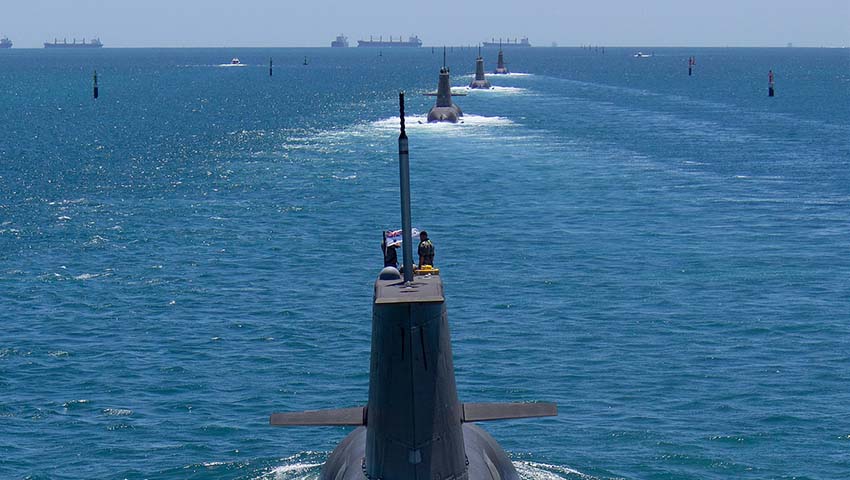Former RAN officer Chris Skinner explains how Australia could fill a potential capability gap exposed ahead of the delivery of a nuclear-powered submarine fleet promised under the AUKUS alliance.
The momentous announcement on 16 September (AEST) of the tripartite AUKUS alliance was extraordinary but was further overshadowed by the declaration of joint UK and US support for transfer of nuclear propulsion know-how to Australia for us to build a nuclear submarine force of at least eight boats that would start construction around 2030 and deliver from 2040 onwards.
The consequential termination of the Attack submarine program has angered France but occurred at a contractually defined decision point before detailed design began in earnest.
The issue apparent to most observers is the possible reduction in submarine capability from the decommissioning of the current Collins Class boats 10 years after they complete life-of-type-extension (LOTE), which runs from 2026 through 2035, so all gone by 2045. Even with no unexpected problems, those dates only suggest two or three nuclear boats by then so the force would be depleted.
Again, the many observers have suggested that we seek to lease SSNs from the UK or US to cover the transition and to provide a progressive path to gain experience and skills leading ultimately to a sovereign nuclear submarine force. However, that isn’t necessarily a straightforward approach.
For the UK they would argue they need all the Astute Class they are building (seven boats) with the last to be delivered in 2026. What might be feasible if we act quickly is to prevail on the UK to keep the Astute production line open for a few more boats for Australian lease or purchase.
There would still need to be some adaptation of the Astute combat system to accommodate our use of the Mark 48 torpedo and AN/BYG-1 combat control system in which we partner with the US.
For the US, there is even less likelihood of readily available Virginia Class, which are being produced at a fast rate until 2033. Leasing boats of earlier design is not cost-effective by the time we had trained crews they would have reached their use-by date. Extending the Virginia production line would not deliver SSNs for Australia to meet our timeline needs.
There has been speculation that the joint approach by the US and UK to make nuclear submarine technology available to Australia might lead to competition between US and UK industry on levels and scope of participation. This might not be optimum and could delay the program from Australia’s perspective.
There does seem to be a desirable way ahead that is proposed for consideration as follows:
- Clearly the strategic and industrial expertise of both the US and UK are highly valued for meeting Australia’s needs in a timely manner;
- Both supplying countries are engaged in current SSN production programs that could not be impeded but might be extended beyond current contracted numbers. Of the two, the UK Astute program will reach this point earlier in 2026, which would tie in with Australian commitment to prepare to join the extended program to a progressively greater extent;
- The work already under contract to Lockheed Martin Australia for the Attack program could be redirected to apply to an extended Astute Class; and
- The Astute design could be adapted to permit transfer of the reactor and propulsion suite to be constructed in UK to be joined to forward sections to be built in South Australia with Lockheed Martin contracted to undertake the systems integration under contract to ASC as the prime contractor.
Meanwhile, the Nuclear-Powered Submarine Task Force plan for execution of the program would have been delivered by end of 2022, and the extensive preparations for nuclear vessel construction in South Australia and operation and sustainment initially in Western Australia, and perhaps elsewhere also in later years, would all have been progressed as a matter of utmost priority.
The UK has already spoken of a greater presence in the Indo-Pacific and basing one or more Astute Class in WA would be a positive step consistent with that broader strategic intent. This would greatly facilitate the interaction between Royal Navy and RAN service personnel and for the inclusion of Australian naval people in RN boats for training and ultimate qualification.
Even today the standards for training and qualification for crew organisation and naval culture in the RAN are closer to those of the UK Royal Navy that to the US Navy and so taking the Astute path would be more readily achieved in both time and workforce terms.
This would deliver the following benefits:
- Earlier realisation of an Australian nuclear powered submarine force;
- Achievement of the UK strategic objective of greater Indo-Pacific presence;
- Making constructive use of the work already undertaken by Lockheed Martin Australia on the Attack program; and
- This would satisfy the US concerns over maintaining their oversight of sensitive US technology while at the same time supporting the goals of AUKUS.
Christopher Skinner served 30 years in the Australian Navy as a weapons and electrical engineer officer in six surface warships, including deployments to South-East Asian Treaty Organisation, the Vietnam War and surveillance of the North-West Indian Ocean. He served overseas on training and ship modernisation programs and was seconded to the United States Naval Sea Systems Command in Washington DC to manage the test and evaluation of the lead ship of a joint Australian-US frigate program. He is a member of several organisations and institutes engaged in geopolitics, technology and submarine matters, and is a councilor of the Australian Institute of International Affairs, NSW division. The views expressed above are entirely those of the author and are not endorsed by any of the organisations of which he is a member.









